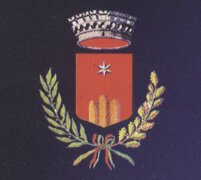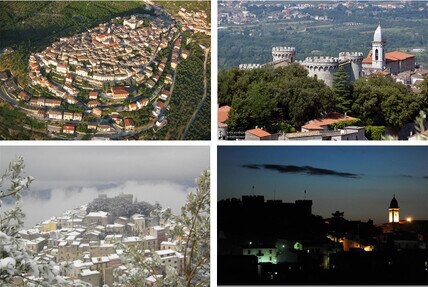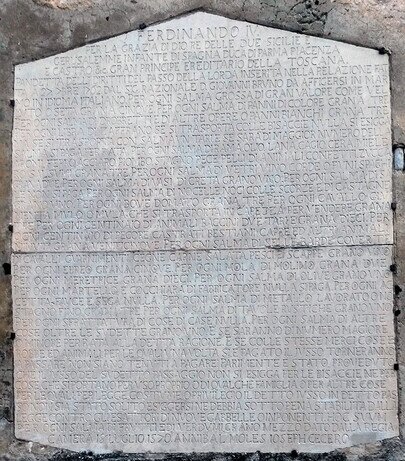The History of Monteroduni
Population Name: Monterodunesi
Current mayor: mayor (Nicola Altobelli)
Population: 2108 people (28/02/2025 - ISTAT)
Density: 61,99 people/km²
Height s.l.m.: 447
Latitude: 41° 31' 27''
Longitude: 14° 10' 36''
Surface: 37,02 Kmq.
Cadastral code: F601
Istat code: 094030
Prefix: 0865
Cap: 86075
Nation: Italia
Region: Molise
Provincia: Isernia (IS)
Area: Southern Italy
Patron: S. Michele Arcangelo 29 settembre
Seismic hazard: area 1 (alta): PGA ³ 0,25g
Class Climate: area D, 1903 GG
 The town's coat of arms
The town's coat of armsIn ancient times Monteroduni was located only inside its town walls. The town’s coat of arms represents three hills with a star on top.

The Origins of Monteroduni
Monteroduni covers a geographical area of about 3700 hectares and the town sits at 450 meters above sea level. Monteroduni was originally named after a Lombard lord, vassal of Count Landulf of Isernia, who strengthened the hill around the year one thousand.
The toponym Monte Rodoni appears for the first time in a document of 1105, currently preserved in the Archive of the Abbey of Montecassino.
Due to Monteroduni's strategic location and its abundance of water streams, Monteroduni has always been a highly frequented area through the eras. Monteroduni's peculiar geographical location runs alongside the natural border of Lazio and Campania on one side and Molise and Abruzzo on the other, therefore has always been an obligatory point of passage for transit through these regions.
Monteroduni's abundance of water streams and therefore its fertility, it's marked by the course of the main river Volturno and its tributaries Vandra and Lorda, as well as by numerous secondary springs and waterways.
It is a territory rich in history and natural beauty. There are many remains and signs of the past that are still present and today allow, thanks to what has been done so far by archaeological research, to reconstruct the picture of the human settlements that have gradually happened over the centuries, starting from the Acheulean age (about 400 thousand years BC), as evidenced by its beautiful double-sided areas found in Guado S. Nicholas, which today are preserved at the Paleolithic Museum of Isernia.
The first known residential settlement was located in the district now called 'Paradise', which experts in the field believe coincides with the statio of Ad Rotas, so indicated in the Tabula Peutingeriana, an ancient map discovered in 1503 that shows the itineraries of imperial Rome.
In all probability the territory of Monteroduni was affected by the wars between the Romans and the Sannites because the strategic position, very close to the Matese, made it a point of passage for the entry of the armies into the Sannio Pentro. Under the Roman Empire, and precisely under Augustus, the part of territory south of the Volturnus was inscribed in the Teretine tribe while the part to the North, and therefore the vicus (village) of Ad Rotas, to the Tromentine tribe. The new territorial structure also brought improvements in the viability with the construction of the road that connected the important Roman municipalities of Venafro and Isernia to Boiano. In 456 the village of Paradiso was targeted by the vandals who marched towards Isernia, and in 881 of the Saracens who destroyed the nearby Abbey of S. Vincenzo at the Volturno.
Over the years and until the nineteenth century, the history of Monteroduni was linked to the fate, favourable or not, of the feudal lords who held the castle. Monteroduni was a fief of considerable importance and, alternately, passed from the crown to the most important families of the Kingdom including the D'Evoli, the Caetani, the D'Afflitto and from 1668 to the Princes Pignatelli Leonessa, who transformed it into a luxurious residence.
Truduced
Dott. Sarah Basile
Public works: Aqueduct, the first lighting, the first post office, and the first railways.
-In 1193 Monteroduni was destroyed and left without water for about 800 years. Several houses had wells and cisterns, fed by rainwater used only for household chores. There were many natural springs, still existing (Capotrio, San Nazzaro, La Fontana etc ....), which supplied water to drink. The first real and current waterworks in Monteroduni were designed in 1934 and tested in 1938. It has started to work since 14th September 1938.
Reliable sources reveal that Monteroduni was the first town of the area to have lighting. In fact, on 20th November 1883 the town had its first electric plant. On 28th October 1913 public lightning was inaugurated. The electricity was supplied by a plant that used the water of the lake itself, owned by Prince Pignatelli and located in Contrada S. Nazzaro.
The first post office in Monteroduni was established in 1881 and in 1899 a telegraph office was also set up.
The railway Caianello-Campobasso, which also includes the stations of Monteroduni (Spinete) and Macchia d'Isernia, was inaugurated on March 21th, 1894. It was later destroyed during the Second World War and restored in 1950 with the current station.

The Pandetta of the Lorda river
The “Pandetta” was a toll fee inscribed on two stones of 1.90x1.60 mt. The stones were placed near the bridge which crossed the Lorda river, the natural boundary between the northern portions of the lands of Macchia d'Isernia and Monteroduni.
Since 1505 the tenure of Macchia and Monteroduni was held by one family, the Afflittos, but in 1564 Ludovico II D’Afflitto sold the land of Macchia to Giovanni Battista Ravaschieri. Giovanni Battista stated that he held Macchia and all the areas around and in 1570 he sold the tenure to Luigi della Marra. So, the tolls that must be paid in order to pass through the territory were two: the first fee had to be paid near the Lorda and the second one near the Cavalieri river, located between Isernia and Macchia. At first, when the original tenure was held by only one family, the toll was paid once, but when it was divided into two different tenures, people had to pay two different fees.
Anyway, such problems affected the entire Kingdom; so in 1569, the Duke of Alcala decided that the Summaria Court had to discuss and solve the issue. In turn, the court gave full power to decide to its President, Hannibal Moles.
In various papers filed in the Summaria Court, it’s written that in 1570 all the Barons of the Kingdom were invited to explain the reason for the tolls they required. For what concerns the case Macchia – Monteroduni, discussed in court in the same year, there’s a file describing Ravaschieri who shows papers in order to prove his right to require the toll inside his own tenure.
At the same time, Hannibal Moles decreed that the toll had to be required only once and its price had to be the same as the original one (the original price was reported on a paper which were attached to the files regarding the case). Furthermore, to avoid the abuse of power, the list of the various toll charges required had to be showed to the people who passed through the land and the two crumbling bridges had to be fixed suddenly.
In order to cross the river, people could also use the scow (scafa) instead of the bridge, but in order to get this alternative service, they had to pay either for their transfer or for the goods transported, in addition to the rights of passage.
For nearly two centuries, the route of the Lorda river, which connected Macchia to Monteroduni, became the source of contention between the two towns, because both the Baron of Macchia and the Prince of Monteroduni believed that the route was located in their own tenure.
Surely this was one of the reasons why the build of the new bridge on the Lorda delayed significantly.
The disputes were finally resolved in 1806, when Napoleon's brother, Joseph Bonaparte abolished feudalism.

